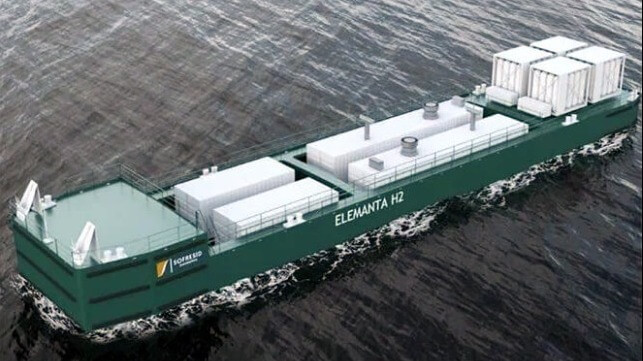Hydrogen-Power Fuel Cell Barge to Provide Shore Power for Ships

A partnership of French companies plans to develop the first hydrogen-powered fuel cell barge to provide power for ships while at berth in port. The goal is to develop a green or low carbon alternative to provide cold ironing services for containerships, tankers, and cruise ships that reduce emissions and the demand placed on power grids in the ports. They estimate that they can reduce emissions by large ships by more than 80 percent during port calls.
The partners of the Elemanta H2 project signed a memorandum to design and deploy their mobile solution for powering ships in port. The power barge will be commissioned in 2025 for a 20-year operating period. They believe it will serve as a demonstrator for the opportunities to provide a low-carbon alternative to the diesel generators that currently power ships at berth.
The use of shore power is growing rapidly, especially in Europe where pending regulations focus on the air quality and emissions in the major ports. Primarily used by passenger ships and ferries, shore power is expanding with the first applications being demonstrated for tankers.
The objective is to standardize and replicate their hydrogen-powered solution, with higher power levels, in the main European ports, including future large hydrogen hub projects. They noted that the hydrogen can be produced locally, possibly for green resources such as wind power, and would also reduce the impact of the volatility of international fossil fuel markets.
With the support of Normandie Energies and the port operator HAROPA, a demonstration barge will employ a high-power hydrogen fuel cell system manufactured in France by HDF Energy. Other participants in the Elemanta H2 project include ArianeGroup, Amethyste, CETIM, and Sofresid Engineering. Sofresid Engineering will carry out the architecture and the integration of the equipment of the barge, which will be mobile to move as close as possible to the need and maximize its utilization rate.
The partners have identified the Port of Rouen and the Rubis Terminal location as a pioneer site because of its strategic position. They noted that it is located between the Grand Port Maritime du Harve and the ports of Paris. The Port of Rouen has access both to ocean-going vessels as well as river traffic on the Seine. It is the leading port in western Europe for gain exports and also has operations for chemicals, containers, and ro-ro vehicles. The port has also been receiving significant upgrades to accommodate new-generation bulk carriers, with a greater draught including deepening and improving nautical channels and the addition of new port equipment.

that matters most
Get the latest maritime news delivered to your inbox daily.
As part of the power project, the partners plan a high-pressure green hydrogen storage system that will cover the need for autonomy during port calls for the power barges. Elemanta H2 is also targeting enabling hydrogen bunkering to meet the refueling needs of future hydrogen ships.
